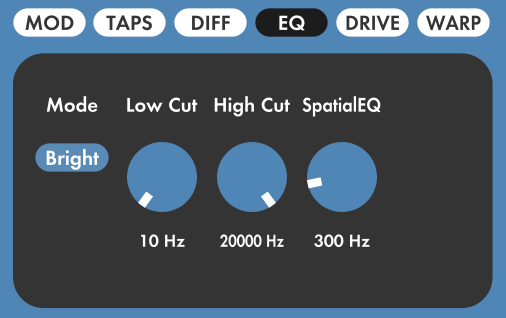ValhallaUberMod: The EQ Parameters
The EQ section in ValhallaÜberMod has a few straightforward parameters, as well as a few that require deeper explanation. By adjusting the parameters, the user can create bright, clean echos, as well as dark, tape-esque decays. The EQ section is inside the feedback loop of ValhallaÜberMod, so any changes to the EQ will be multiplied by each feedback iteration.
The EQ controls:
- EQ Mode: controls the overall “color” of the EQ section, and of ÜberMod as a whole. The choices are Bright and Dark, and are fairly self explanatory. It is worth noting that the EQ Mode control has a far more dramatic effect when the DIFF section is enabled.
- EQ Low Cut: controls the cutoff frequency of a -6 db/oct high pass filter. Useful in reducing the amount of low frequencies in the signal.
- An “analog” echo will have this set to a fairly high frequency (150 Hz or more), such that the feedback signal “thins out” as it decays.
- Cutting the low frequencies out of a chorus can be useful in creating a clearer sound.
- EQ High Cut: controls the cutoff frequency of a -6 db/oct low pass filter. Useful in reducing the amount of high frequencies in the signal.
- Setting EQ High Cut above 10 KHz is useful for “digital” delays and modulation effects, as well as any type of effect that benefits from extended high frequency response (such as flanging).
- An EQ High Cut setting around 10 KHz is useful for emulating the high frequency response of BBD-based chorus and ensemble units.
- For emulating tape echos and BBD echos, set EQ High Cut to a fairly low frequency (3KHz or lower).
- EQ SpatialEQ controls the cutoff frequency of the crossover used in the “crosstalk” mixer controlled by the WIDTH slider. When WIDTH exceeds 100%, the output of one delay channel is inverted in phase and mixed in with the output of the opposite delay channel, to create a wider “pseudostereo” effect. This phase inversion can result in a loss of bass frequencies, so the EQ SpatialEQ is used to control a crossover that determines at what frequency the inverted mixing occurs.
- The SpatialEQ algorithm was inspired by the complex filtering found in the Dimension D chorus, but has been extended to work with greater numbers of delay taps. A lot of research went into developing an algorithm that would have unity gain for all settings of WIDTH.
- By setting EQ SpatialEQ to 150 Hz or higher, the bass frequencies of the delayed signal will be maintained for all settings of WIDTH. Adjust this by ear to suit the input signal, or just set this to 300 to 400 Hz to ensure that the bass energy doesn’t get cancelled out.
- Setting EQ SpatialEQ to a lower frequency can result in cancellations of the bass frequencies. This can be useful for producing hollow flanging sounds, such as those heard on the “Axis: Bold as Love” album.




